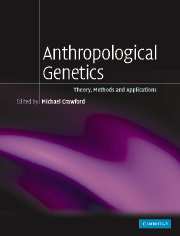Book contents
- Frontmatter
- Contents
- List of Contributors
- Preface
- Chapter 1 Foundations of Anthropological Genetics
- Part 1 Theory
- Part 2 Methods
- Part 3 General Applications
- Part 4 Part IV The Human Diaspora
- Chapter 12 Human Origins Within and Out of Africa
- Chapter 13 The Peopling of Europe
- Chapter 14 The Peopling of Oceania
- Chapter 15 The Prehistoric Colonization of the Americas
- Chapter 16 Anthropological Genetics: Present and Future
- Index
- References
Chapter 12 - Human Origins Within and Out of Africa
Published online by Cambridge University Press: 05 June 2012
- Frontmatter
- Contents
- List of Contributors
- Preface
- Chapter 1 Foundations of Anthropological Genetics
- Part 1 Theory
- Part 2 Methods
- Part 3 General Applications
- Part 4 Part IV The Human Diaspora
- Chapter 12 Human Origins Within and Out of Africa
- Chapter 13 The Peopling of Europe
- Chapter 14 The Peopling of Oceania
- Chapter 15 The Prehistoric Colonization of the Americas
- Chapter 16 Anthropological Genetics: Present and Future
- Index
- References
Summary
Abstract
Comparative studies of ethnically diverse human populations are important for testing historical hypotheses relating to the origin and dispersal of modern humans. In this chapter, we summarize the competing theories about how, when and where modern humans originated. We describe levels and patterns of genetic diversity across modern human populations and review the genetic evidence concerning modern human origins. We also discuss genetic signatures of population migrations within and out of Africa by contrasting and comparing these genetic signatures with global patterns of genetic diversity. Finally, we discuss implications of molecular data for reconstructing the demographic histories of African and non-African populations.
Introduction
The origin and dispersal of modern humans across the globe remains a topic of considerable interest and debate. While this topic has historically been within the realm of paleoanthropology based on fossil and archeological data, this topic is now being addressed in the fields of genetics and molecular biology. Genetic data, primarily gene frequency variation at polymorphisms, have been used to examine population similarities since the study of ABO blood type frequencies by Hirszfeld and Hirszfeld in 1919 (Hirszfeld and Hirszfeld, 1919). In the subsequent decades, hundreds of populations have been studied for blood group loci, serum protein polymorphisms, and various enzyme electrophoretic polymorphisms (Cavalli-Sforza et al., 1994). The advent of molecular biology techniques, including Restriction Fragment Length Polymorphisms (RFLPs) and Polymerase Chain Reaction (PCR) in the 1980s, mtDNA sequence variation in the 1980s, and nuclear sequence variation, Single Nucleotide Polymorphisms (SNPs), Short Tandem Repeat Polymorphisms (STRPs), and Alu polymorphisms in the 1990s until present, have made it feasible to do much more detailed, high-throughput studies of the distribution of molecular variation in globally diverse human populations.
- Type
- Chapter
- Information
- Anthropological GeneticsTheory, Methods and Applications, pp. 337 - 379Publisher: Cambridge University PressPrint publication year: 2006



